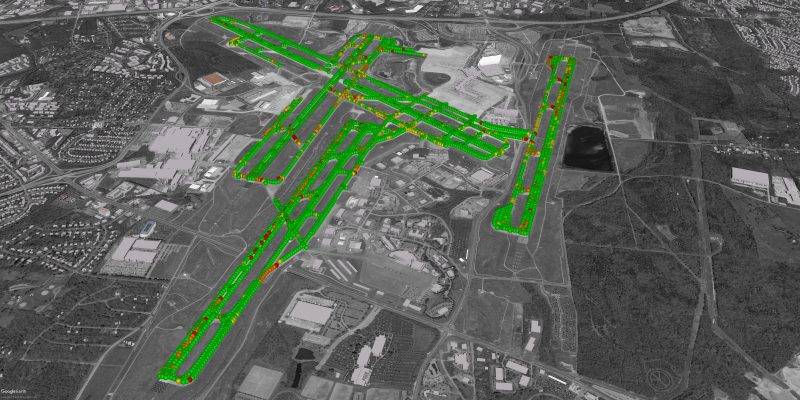










AIRFIELD MARKING ASSESSMENT
Introducing Mobi - the only mobile reflectometer (made in the USA) customized to assess your airfield. Using Mobi's cutting-edge technology, our expert technicians drive your airfield continuously scanning your runway and taxiway markings 400 times/second collecting critical retro-reflectivity data. Based on FAA criteria, color coded conditions are overlayed on an interactive map of your airfield. The data can be fully integrated with your existing GIS/asset management system or our specialized AMAx software.
Imagine the value in knowing which markings require maintenance and having a prioritized plan of attack.
SPEND LESS ON MARKINGS
Our assessment teams have collected extensive reflectivity data over the years and the industry trend is clear: airports spend more money than they have to repainting airfield markings.
Based on nearly four million reflectivity scans, 5% of the data falls below minimum levels established by the FAA. Another 31% is marginal and may need maintenance soon. Over half of the data is in good or excellent condition. This means that your airport may be spending twice as much as it needs to.
There's a better way. Getting an Airfield Marking Assessment first will identify what you don't have to paint this year, saving you thousands in the process. You can't afford not to use an assessment - it's fast and affordable - often paying for itself by reducing maintenance costs.

IN COMPLIANCE
Part 139 commerical airports are required to ensure runway and taxiway markings are compliant and properly maintained according to the Code of Federal Regulations:
14 CFR § 139.311(d) Maintenance. "Each certificate holder must properly maintain each marking, sign, or lighting system installed and operated on the airport. As used in this section, to 'properly maintain' includes cleaning, replacing, or repairing any faded, missing, or nonfunctional item; keeping each item unobscured and clearly visible; and ensuring that each item provides an accurate reference to the user."
Based on national data provided by the Federal Aviation Administration (FAA), the majority of discrepancies cited during airport certification safety inspections fall into this category.
Effective December 21, 2018 the FAA further defined minimum requirements for airfield marking retro-reflectance (nighttime visibility) in Advisory Circular (AC) 150/5370-10H, P-620. As a result, airports must measure airfield marking retro-reflectance to know with certainty whether they are in compliance, "clearly visible", and providing an "accurate reference to the user".

BOTTOM LINE
The smartest way to maintain your airfield markings is to use an assessment-first strategy. Join the many airports already saving thousands of dollars and ensuring compliance by getting an airfield marking assessment. Your first step is getting a quote.
★★★★★
"Sightline's positive impact to the culture at Charlotte Douglas Int'l was profound; I can still see the difference in our work years after consulting with them. The
training and custom work plan they delivered were exactly what we needed, and some of the best consulting work we've ever had."
— Chad Huskins, Field Maintenance Manager, Charlotte Douglas International Airport
★★★★★
"The markings assessment was thorough, comprehensive, and presented in a professional manner... The marking recommendations and priorities were exactly the end
product I wanted."
— Floyd Crook, Director of Maintenance, Nashville International Airport
★★★★★
"We passed Part 139 with flying colors with special comments on our striping. We could not have done it without Sightline."
— Curtis Wilkins, Maint. & Const. Supervisor, Oakland International Airport
Read about how BNA saved $350,000 with an assessment-first strategy in the 2020 Runway & Ramp issue of Airport Improvement Magazine. Click the cover image to read.



